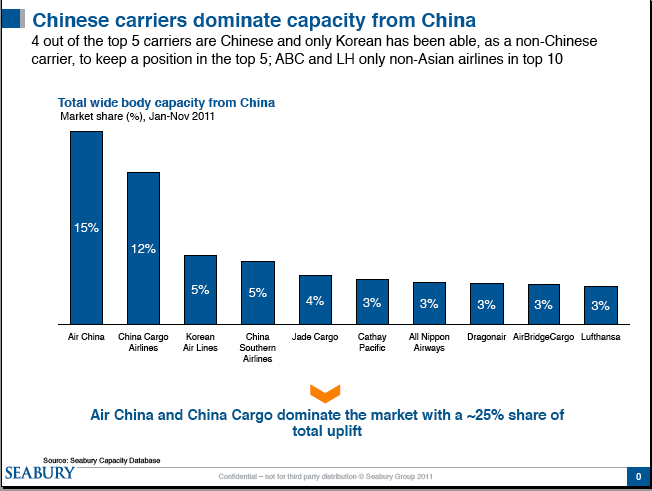

China’s leading
carriers will continue to occupy a more prominent position on international
routes to and from the country as government policies and their own
investments enable them to build market share, believe leading analysts
and industry executives contacted by FlyingTypers.
According to figures from the
Seabury Group, four of the top carriers in China on international
scheduled routes featuring wide-bodied capacity are already Chinese,
with Air China leading the way with 15 percent of the market (see
chart). The only foreign carrier to make the top five is Korean Air
Lines with 5 percent of the market. Integrators, which currently take
a big chunk of cargo markets, do not feature because large parts of
their capacity are typically unscheduled.
A spokesman for Seabury said “the
combined share of the big Chinese carriers increased from 30 percent
a few years ago to 35 percent today.” Carrier executives predict
the trend will accelerate in the future.
 Alvin Tay, Vice President Sales
and Marketing at second-placed China Cargo Airlines (CK) which boasts
some 12 percent of the market, said the Chinese government was encouraging
the growth of Chinese carriers and this had prompted the formation
of several cargo joint ventures over the last few years, not least
CK itself, in which China Eastern Air Holding Company holds 51 percent,
China Ocean Shipping Group [COSCO] 17 percent, and both EVA Air and
Singapore Airlines Cargo retain 16 percent each.
Alvin Tay, Vice President Sales
and Marketing at second-placed China Cargo Airlines (CK) which boasts
some 12 percent of the market, said the Chinese government was encouraging
the growth of Chinese carriers and this had prompted the formation
of several cargo joint ventures over the last few years, not least
CK itself, in which China Eastern Air Holding Company holds 51 percent,
China Ocean Shipping Group [COSCO] 17 percent, and both EVA Air and
Singapore Airlines Cargo retain 16 percent each.
“During the Great Recession
of 2009, the Chinese government identified logistics as one of the
ten key industries of the Chinese economy,” he said. “In
that respect, being part of the logistics chain, freight carriers
are certainly part of that equation. In the latest 12th Five Year
Plan, logistics is again identified as one of the key service industries
that must see greater development and growth.
“We believe Chinese carriers
will continue to grow and expand their network and presence on overseas
lanes. For China Cargo, we will continue to look at our network to
rationalize and improve it. We will be increasing frequencies to existing
destinations and adding new points to the network as we expand our
fleet.”
He admitted China would remain
a target for foreign lines looking to expand, but said the market
would favor those with domestic networks. “[Foreign carriers
are expanding at] all established airports such as Beijing, Shanghai
and Guangzhou, but also at up and coming airports in the western part
of China,” he said. “We
expect Chinese carriers to gain more market share but at the same
time we have to note that the overall market is expanding.”
 |
Won-Joon Lee, a Managing Partner
at consultants Accenture, said China’s airlines have a huge
opportunity in the coming years to win a growing share of international
business and build a strong presence at both ends of the supply chains
into and out of China.
“The reason is that China
as a country, and its leading operators, are currently investing in
a massive capacity expansion,” he told FlyingTypers.
 |
He said that over the
next five years, China planned to build 45 new airports as part of
a RMB1,500 billion investment in its aviation sector, including the
construction of ‘merchant’ airports dedicated to cargo
movements.
“This is providing the opportunity
to leapfrog established competitors with outdated infrastructure by
putting in place new logistics based on the latest thinking and management
technologies,” he said. “In turn, Chinese operators—and
those with international joint venture partners—should be able
to offer highly competitive pricing and superior service.
“If China’s new airports
are created in a strong partnership with the air cargo industry, there
is a significant opportunity to put in place exceptionally efficient
processes that enable the same sort of gains that other leading Asian
destinations such as Korea and Singapore have achieved in both freight
and passenger carriage.
“If China’s airline
industry can make similar gains, it not only stands to win a greater
share of the cargo market, it should help to make air cargo more competitive
with sea and land freight.”
SkyKing
|








